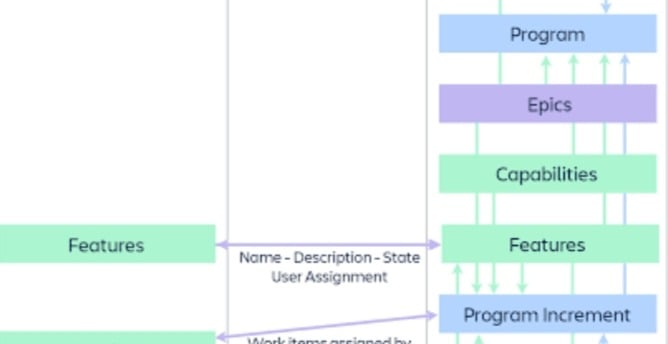Introduction
In the world of Agile, Scaled Agile Framework (SAFe) has gained significant popularity as a scalable and flexible approach for managing large-scale projects. One critical aspect of managing complex projects is dependency management, which involves identifying and tracking dependencies between various tasks, teams, and features. To facilitate this process, several dependency management subtools have emerged. In this article, we will focus on two front runners in the market: Jira Align and Azure DevOps. We will explore the benefits of each tool and discuss the subtools they offer for effective dependency management.
Jira Align
Jira Align is an enterprise Agile planning platform that provides a comprehensive set of features for managing dependencies in Agile, Scaled Agile, and SAFe environments. It offers the following subtools for dependency management:
1. Dependency Mapping
Jira Align allows teams to visualize and map dependencies between various tasks, features, and teams. This subtool provides a clear and intuitive view of the dependencies, enabling teams to identify potential bottlenecks and plan accordingly. The benefits of dependency mapping in Jira Align include:
- Improved visibility: Dependency mapping provides a holistic view of the project, allowing teams to identify and address potential risks or delays.
- Efficient planning: With a clear understanding of dependencies, teams can plan their work more effectively, ensuring that tasks are executed in the right sequence.
- Collaboration: Dependency mapping encourages cross-team collaboration, as teams can easily identify and communicate dependencies, fostering a more cohesive and integrated approach to project execution.
2. Dependency Tracking
Jira Align also offers a robust dependency tracking subtool that allows teams to monitor and manage dependencies throughout the project lifecycle. This subtool provides the following benefits:
- Real-time updates: Teams can track the status of dependencies in real-time, ensuring that any changes or delays are immediately visible and can be addressed promptly.
- Proactive risk management: By tracking dependencies, teams can identify potential risks and take proactive measures to mitigate them, minimizing the impact on project timelines.
- Improved decision-making: Dependency tracking provides teams with accurate and up-to-date information, enabling them to make informed decisions based on the current status of dependencies.
3. Dependency Resolution
Jira Align offers features that facilitate the resolution of dependencies, ensuring smooth project execution. The benefits of dependency resolution in Jira Align include:
- Conflict identification: The tool helps teams identify conflicts or clashes between dependencies, enabling them to resolve them before they impact project timelines.
- Automated alerts: Jira Align can send automated alerts or notifications when there are conflicts or delays in dependencies, ensuring that teams are promptly informed and can take appropriate action.
- Agile adaptability: Jira Align's dependency resolution features are designed to align with Agile principles, allowing teams to adapt and adjust dependencies as needed without disrupting the overall project flow.
Azure DevOps
Azure DevOps is a comprehensive platform that offers a wide range of tools and services for managing Agile projects. While it may not be specifically tailored for SAFe, it provides several subtools that can support dependency management. Let's explore some of these subtools and their benefits:
1. Backlog Management
Azure DevOps provides an intuitive backlog management subtool that allows teams to prioritize and manage their work items effectively. While not specifically focused on dependency management, this subtool offers the following benefits:
- Visual representation: Teams can visualize their backlog items and their relationships, enabling them to identify dependencies and plan accordingly.
- Flexible prioritization: With backlog management, teams can easily prioritize work items based on their dependencies, ensuring that tasks are executed in the right sequence.
- Collaboration: Azure DevOps facilitates collaboration by providing a centralized platform for teams to discuss and align on backlog items, fostering a more cohesive approach to project execution.
2. Boards and Work Tracking
Azure DevOps offers boards and work tracking features that enable teams to track and manage their work items efficiently. While not specifically designed for dependency management, these subtools provide the following benefits:
- Task visualization: Teams can visualize their work items on a board, allowing them to identify dependencies and plan their work accordingly.
- Progress tracking: Azure DevOps provides real-time updates on the status of work items, enabling teams to track dependencies and address any delays or bottlenecks promptly.
- Collaboration: Boards and work tracking features encourage collaboration by providing a centralized platform for teams to discuss and update the status of their work items, fostering transparency and alignment.
3. Release Management
Azure DevOps offers a release management subtool that allows teams to plan and track their releases effectively. While not specifically focused on dependency management, this subtool provides the following benefits:
- Release planning: Teams can plan their releases and identify dependencies between various features or components, ensuring that dependencies are managed effectively.
- Release tracking: Azure DevOps provides real-time updates on the status of releases, enabling teams to track dependencies and address any delays or issues promptly.
- Continuous integration and deployment: The release management subtool integrates with Azure DevOps' CI/CD capabilities, allowing teams to automate the deployment process and ensure smooth execution of dependencies.
Conclusion
Dependency management is a critical aspect of project management in Agile, Scaled Agile, and SAFe environments. Both Jira Align and Azure DevOps offer subtools that facilitate effective dependency management. Jira Align provides a comprehensive set of features specifically designed for dependency management, including dependency mapping, tracking, and resolution. On the other hand, Azure DevOps offers a range of tools and services that can support dependency management, such as backlog management, boards and work tracking, and release management. The choice between these tools ultimately depends on the specific requirements of the project and the organization. It is recommended to evaluate the features and benefits of each tool in relation to your project's needs before making a decision.


